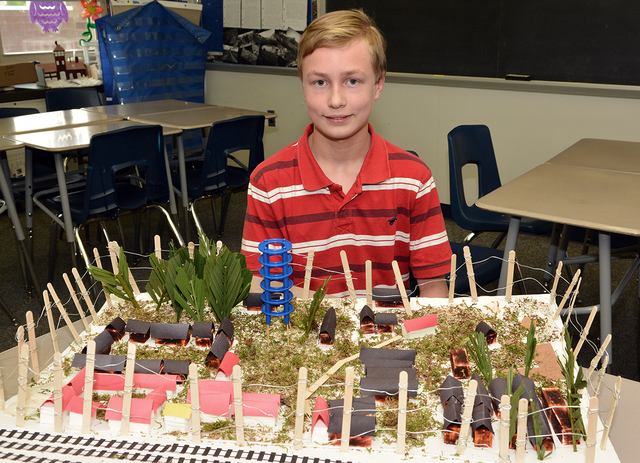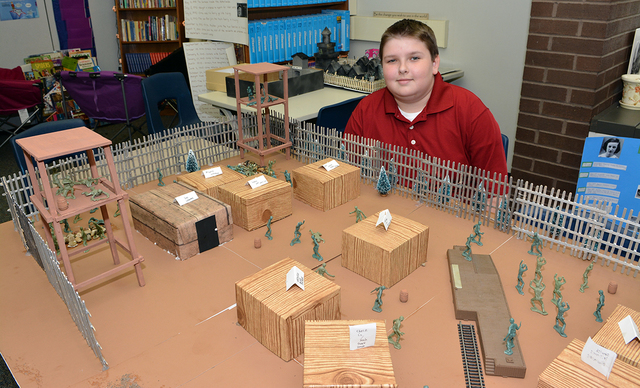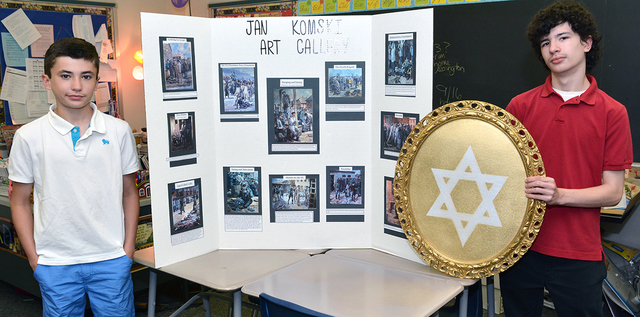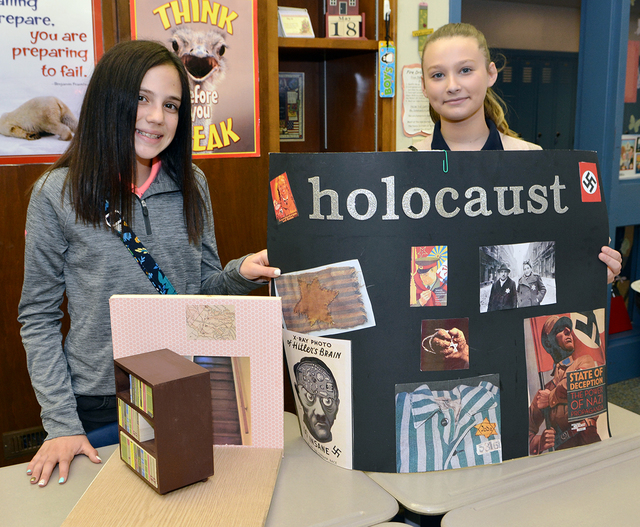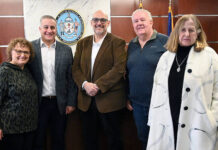Editor’s note: This story has been updated with clarifications.
HUGHESTOWN — For 12-year-old Justin Bryk, his latest school project seemed like a typical assignment until his research hit close to home.
While learning about Anne Frank and the Holocaust in his reading class, Bryk presented a series of paintings that were created from his great-great uncle Jan Komski, a Holocaust survivor.
“I was shocked,” Bryk said of realizing Komski is his relative. “I was just surprised that my great-great uncle was in the Holocaust, and he actually escaped five camps.”
The project Bryk presented is one that all seventh grade students in their reading class have to present while learning about Anne Frank and the Holocaust.
The Holocaust is the name for the genocide in which 6 million Jews were killed in Europe, and Anne Frank, a German-born diarist, is one of the most discussed victims of that time period.
Seventh grade reading teachers Sarah Donahue and Katie Martin said they usually spend the last month or two of the school year teaching students about Anne Frank and then have students present projects about the Holocaust.
“We give them eight different choices,” said Martin. “They can do a timeline on somebody, they can research a rescuer, someone who was a Nazi and then sided with the Jewish people; an art model, or they can build something. We let them design their own as long as it’s relative to the unit.”
The students must also give a two- to five-minute presentation on the project and what they learned.
Donahue said students are graded on their presentations and if they were able to present something new to their peers.
“I’m looking for them to learn something that I haven’t told them already,” she said. “I have to sit and listen to 120 projects, so I want to learn something new. I don’t want to hear about Anne Frank’s life or the Holocaust in general because that’s what we’ve been going over.”
Most students went above and beyond Anne Frank, but 13-year-old Emily Renaldi stuck with that topic by creating a model of the bookcase that hid the stairs to attic in which the Frank family hid.
“It hid eight people and they were hiding in there because they were Jewish,” she said. “Otto Frank, before it happened, he went back there and he made it and brought furniture up in the attic.”
Renaldi made her project out of wood and wall paper, and also put hinges on the bookcase to open like a door.
Students Matt Soy, 13, and David Stoshick, 13, focused their projects on Nazi camps.
Soy’s project was the Belzic extermination camp in German-occupied Poland in which Jews were held prisoner and later put to death.
He used toy soldiers to represent the German Nazis and the prisoners, and he cut guns off those representing the prisoners to make it look like they’re surrendering.
“I learned a lot of facts that I really didn’t know about the camps,” Soy said. “Facts like what soldiers were told to do or not to do.”
Stoshick’s project was a map of Sobibor, another extermination camp in German-occupied Poland.
“I had to research how the layout was, where everything was and the size of the buildings,” he said of constructing his project.
The houses were made out of makeup sponges and some were white with red roofs while others were painted dark colors with black roofs, which separated the buildings held prisoners from those that held soldiers.
Another symbol of the Holocaust is the Star of David, which Sam Capitano researched.
The 13-year-old painted his project silver at first, and then when the paint dried he placed a star over the project and painted gold around it.
“It symbolizes what Jews had to go through,” Capitano said on why he chose his project. “It’s what they had to wear to identify them as a Jew, and when they had to wear it to identify them as a Jew, they were discriminated against a lot in public.”
Ava Musloski, 13, focused on the propaganda of the Nazis by cutting out posters and pictures which were used by the Nazi Party in the years leading up to and during Adolf Hitler’s leadership of Germany.
The propaganda was a crucial instrument for acquiring and maintaining power and for the implementation of Nazi policies.
“It took me a week to find all of the information I needed for this project,” Musloski said. “It helped with why Jewish people believed in it and why the Germans used (it), and that’s how they gained all of their power… the Jewish people believed the propaganda because when they were in the camps that was all they saw and all they heard.”
Martin and Donahue, who have been assigning the projects for the last five years, were pleased with what their students showed.
With the school year ending and fatigue among the students setting in, they agreed the project is a good way to keep everyone interested and not mentally checked out for the summer.
“At the end of the year, it’s a blessing,” said Martin.
